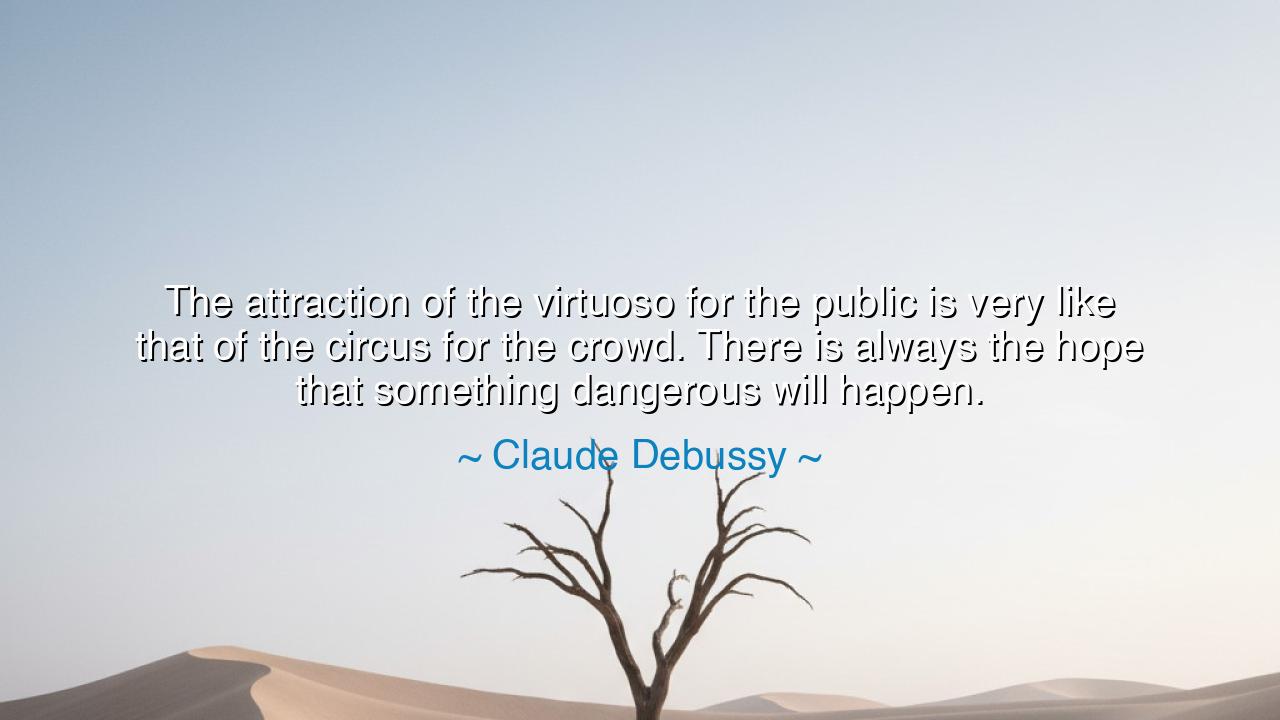
The attraction of the virtuoso for the public is very like that
The attraction of the virtuoso for the public is very like that of the circus for the crowd. There is always the hope that something dangerous will happen.






In the luminous words of Claude Debussy, the dreamer of tones and painter of silence, there echoes a profound observation of both art and humanity: “The attraction of the virtuoso for the public is very like that of the circus for the crowd. There is always the hope that something dangerous will happen.” These words, poetic and piercing, remind us that beneath the admiration we offer to genius lies a hidden hunger — the desire not merely to witness beauty, but to stand at the edge of risk. Debussy, who reshaped the sound of the modern world, understood that audiences do not come to the concert hall only to be soothed — they come to feel the tremor of danger, to taste the nearness of failure that makes triumph so divine.
To understand this saying is to recognize the nature of the virtuoso — that rare soul whose mastery of an art seems to defy human limitation. Whether it be a pianist whose fingers blur like flames, or a dancer who hovers between earth and air, or a poet whose words balance on the brink of madness, the virtuoso is admired not merely for perfection, but for peril. The crowd holds its breath not because the artist plays safely, but because they sense the abyss beneath each note. It is this thin line — between control and chaos — that awakens awe. As in the ancient arenas where gladiators fought before the Roman masses, or in the high-wire acts of the circus, humanity is forever enthralled by those who dare the impossible before our very eyes.
Debussy spoke these words not to mock the public, but to reveal a truth about the drama of art itself. For what is art, if not a kind of sacred risk? To create greatly is to walk into uncertainty, to risk ridicule, failure, and madness. The virtuoso — in music or in life — embodies this eternal gamble. Every performance is a duel between mastery and surrender. The crowd, sensing this battle, leans forward with a mixture of admiration and anticipation. Their hearts whisper, “Will the artist fall? Will he falter? Or will he, against all odds, soar higher still?” The artist’s triumph, then, is the triumph of humanity itself — proof that we, though fragile, can rise above fear and shape the sublime from danger.
Consider the legendary Niccolò Paganini, the violinist whom men once believed to be possessed by the devil. His fingers moved with such fury, his sound so fierce and unearthly, that the audience trembled as if witnessing sorcery. Strings snapped beneath his bow; sweat dripped from his brow like rain. Yet even in the midst of chaos, he conjured beauty so perfect that listeners wept. The danger was real — he risked disaster with every performance — but it was precisely that nearness to ruin that made his art unforgettable. Like the circus acrobat suspended above the crowd, Paganini balanced his life between mastery and collapse. Debussy, in his wisdom, understood this — that true art is not the absence of danger, but its transformation into grace.
There is a deeper lesson hidden in these words — a reflection not only on performance, but on life itself. For every human being, in some sense, is a performer upon the stage of existence. We too are watched — by fate, by time, by the generations to come — and the greatness of our life depends not on our safety, but on our willingness to take the leap. The world admires not those who walk the path of caution, but those who dare to walk the tightrope between fear and faith. Whether in love, in creation, or in the pursuit of truth, the most beautiful victories are born from danger embraced, not avoided.
Yet, let us remember, the true virtuoso does not seek danger for spectacle alone. His aim is not to impress, but to reveal. In every trembling note, in every daring stroke, he exposes the raw soul of human striving. The danger is not staged — it is the risk of honesty, of vulnerability, of giving everything without promise of return. That is why great art humbles us. It shows us what it means to live without armor, to create as if tomorrow may never come. The virtuoso’s courage thus becomes our mirror: we see in him what we might become, if only we too had the bravery to dance upon the edge.
Therefore, O listener, learn this from Debussy’s wisdom: do not live as a spectator in the crowd, waiting for another’s risk to stir your soul. Be the one who dares. Let your own life become a performance of grace and courage. Whether you write, build, love, or dream, approach it as the virtuoso approaches his art — with passion so fierce it trembles, with mastery forged through struggle, and with the courage to face the danger of failure. For it is only in the nearness of the fall that the flight becomes beautiful, and only in the presence of danger that the heart learns to truly feel alive.
And so, as Debussy taught through music and word alike, the true artist — and the true human — must never seek safety, but truth, even when it burns. For the song that trembles on the edge of silence, the brushstroke that risks chaos for glory, the soul that dares love despite pain — these are the miracles that remind the world what it means to be alive.






AAdministratorAdministrator
Welcome, honored guests. Please leave a comment, we will respond soon